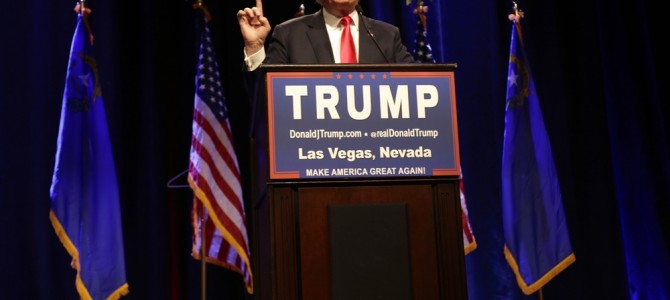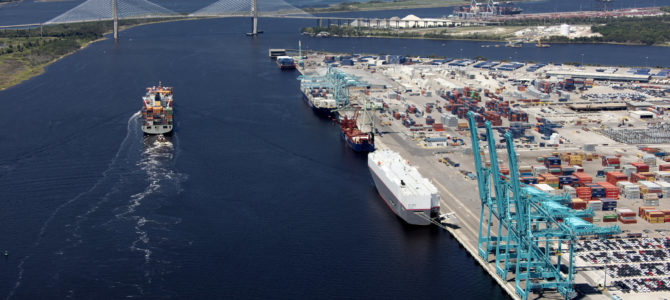
Being sane and strapped for time, I have resisted analyzing Donald Trump’s international trade policy out of the conventional belief—since proven wrong—that he would fade from the political limelight in 2016. But since Trump is apparently here to stay and has amplified his trade rhetoric, a review of one of those plans—to impose high tariffs on Chinese goods—is now warranted. So here we are, and what a disaster this plan is.
There really is no sugarcoating it: almost everything that Donald Trump has proposed on U.S.-China trade—for example, during last Thursday night’s GOP debate, in a recent the New York Times interview, and on his website—is wrong.
Very, very wrong.
Review the Underlying Facts
First, the entire premise of Trump’s plan to retaliate against China is erroneous. Trump cites the U.S.-China trade deficit as proof that the dominant Chinese, via pernicious currency manipulation, are taking weak America’s manufacturing jobs, thereby justifying his tariff plans.
However, as I explained in The Federalist last fall, the U.S. manufacturing sector has been (until the last month or so) setting production (and export!) records, and almost 90 percent of the decline in U.S. manufacturing jobs between 2000 and 2010 was caused by productivity gains (robots and computers), rather than import competition.
In fact, a recent Ball State study found that, “Had we kept 2000-levels of productivity and applied them to 2010-levels of production, we would have required 20.9 million manufacturing workers. Instead, we employed only 12.1 million.” So unless Trump wants to destroy all the robots, those jobs just aren’t coming back, tariff or not.
Furthermore, the idea that the U.S.-China trade balance proves that we’re “losing” at trade is the height of economic ignorance. For one thing, there’s actually a strong correlation between U.S. economic growth and an expanding U.S. trade deficit. As Cato’s Dan Griswold wrote:
An examination of the past 30 years of U.S. economic performance offers no evidence that a rising level of imports or growing trade deficits have negatively affected the U.S. economy. In fact, since 1980, the U.S. economy has grown more than three times faster during periods when the trade deficit was expanding as a share of GDP compared to periods when it was contracting. Stock market appreciation, manufacturing output, and job growth were all significantly more robust during periods of expanding imports and trade deficits.
Moreover, basic economics teaches us that trade balances reflect national savings, consumption and investment, not trade policy. Thus, every dollar traveling overseas to buy imports (in excess of our exports) eventually comes back to the United States in the form of investment, and our “trade deficit” is matched by a “capital account surplus.” In other words, we buy goods and services from foreigners, and they buy an equal amount of our exports plus our financial assets (aka foreign investment in the United States).

In this light, the U.S. trade deficit reflects little more than America’s longstanding comparative advantage as a global investment destination. Not so scary, huh?
Our Trade Balance With China Doesn’t Matter
If fixating on the overall U.S. trade balance weren’t dumb enough, Trump goes one step further and obsesses over an even more meaningless stat: the U.S.-China trade balance. As I’ve examined repeatedly, the proliferation of global supply chains and multinational investment has rendered bilateral trade balances an empty trade policy metric.
Indeed, old-school trade stats like these have become so obsolete that the World Trade Organization has launched a global initiative to determine how better to account for actual trade flows. The most common example of the indisputable obsolescence of the U.S.-China trade deficit is the iPhone: each device imported into the United States from China accounts for about $300 towards the bilateral trade deficit, yet the Chinese get only about six bucks worth of value from the item’s assembly and shipment. Meanwhile, the U.S.-based Apple and its affiliates get hundreds of dollars from an iPhone’s final U.S. sale (for things like design, marketing, and even some manufacturing).
Indeed, the only “analysis” tying the U.S.-China trade balance to American jobs is a bogus one from a left-wing, union-run, and union-funded outfit that has been so repeatedly debunked by legitimate experts that it’s only cited by protectionist unions and political hacks like Chuck Schumer. But, hey, if you don’t want to take my word for it, two American Enterprise Institute scholars further dismantled Trump’s trade deficit blather in their recent recap of Thursday’s debate.
China Is Having Yuuge Currency Troubles
The idea that China is totally dominating the United States is equally absurd. Yes, China has experienced impressive gross domestic product (GDP) growth over the last decade or so, but (a) that’s what developing countries do (especially former centrally planned ones with more than a billion people); and (b) America remains much, much wealthier, greener, more egalitarian, and more productive. It’s not even close—no, really.
Moreover, unless you’ve been living under a rock for the last six months, you’d know that China’s incessant quest for GDP growth through the kind of economic interventionism that Trump just loves has led to some serious economic distortions (e.g., a frightening property market, rampant industrial overcapacity, a banking sector riddled with non-performing loans, and serious capital flight), not to mention crazy stock market turmoil.
You’d also know that Chinese “currency manipulation” is not a serious problem for the United States (probably never was), and that even the most aggressive U.S. currency hawks now acknowledge that China is not hurting the United States by keeping the yuan artificially low. Indeed, China’s “cunning” economic planners are currently struggling to keep their currency from falling, not—as Trump seems to think—from rising. So if Beijing relented to Trump’s fantastical threats and let the market dictate its currency, the result would be a weaker yuan, not a stronger one, as Trump confidently claimed last Thursday night.
Presidents Can’t Make Trade Policy Themselves
Beyond Trump’s erroneous premise, there’s also the little problem of actually imposing his plan under U.S. law and global trade rules. First and most obviously, the president can’t just slap a tariff on Chinese goods, regardless of whether he tells the Treasury Department to declare China a “currency manipulator” (a superficial action that, contrary to Trump’s online plan, isn’t simple and doesn’t permit the imposition of duties).
The U.S. Constitution (Article I, Section 8) gives Congress the sole authority to impose tariffs on foreign-made goods (i.e., “to regulate Commerce with foreign Nations”), so Trump would have to get congressional approval for his big China plan. Considering that the most protectionist Congress in decades couldn’t even pass legislation making currency undervaluation an illegal subsidy (and fretted for months over whether the bill was consistent with the WTO), does Trump really think this current Congress—which failed to pass a similar measure—would agree to his far-more-aggressive plan? C’mon, man.
Second, several U.S. laws govern the imposition of remedial tariffs on Chinese (and other) imports, and these laws have strict procedural, evidentiary, and substantive requirements that can’t just be ignored, even by the president.
Illegally dumped or subsidized imports from China (and other countries) are governed by U.S. anti-dumping and countervailing duty (CVD) laws, respectively, while market-distorting surges in fairly traded imports from all countries fall under the U.S. safeguards law. President Trump’s tariff would totally (and unlawfully) circumvent these laws. As already noted, U.S. law also currently doesn’t allow for using CVD actions to combat alleged currency manipulation.
Finally, the Trump tariff would be blatantly inconsistent with two of the United States’ most fundamental obligations under WTO agreements: (i) Most Favored Nation (GATT Article I—the principle that a WTO member must treat imports from all other members equally) and (ii) the United States’ tariff bindings (GATT Article II—the rule that a WTO Member cannot impose tariffs above the “bound rate” set forth in its tariff schedule).
Such an obvious violation of WTO rules would make for the easiest WTO dispute in the organization’s 20-year history, have serious consequences for the United States (as we’ll discuss next), and would all but ensure that China wouldn’t take Trump’s threat seriously. Maybe President Trump plans to withdraw from the WTO and thereby subject U.S. exporters and investors to high tariffs and other discriminatory barriers WTO rules bar? Good luck, as they say, with all that.
Trump’s Trade Policies Would Hurt the United States
Even assuming Trump wasn’t just making an empty threat and that he somehow convinced Congress to impose the Trump tariff, the result would be a lot of pain for little or no economic gain.
First, as noted above, the Trump Tariff is blatantly WTO-inconsistent, so China would go straight to the WTO and easily win the right to impose retaliatory tariffs on U.S. exports in the amount of the damage caused by the tariff. Assuming the retaliation was something like 45 percent (the proposed tariff level) of about $500 billion (total Chinese imports into the United States in 2015), that would mean about $225 billion in authorized retaliation against U.S. exports and intellectual property.
Considering that U.S. exports to China totaled only about $115 billion in 2015, this WTO-sanctioned retaliation would effectively close the United States’ third-largest export destination—a devastating result for American exporters. As Trump’s trying to win the Iowa caucus right now, maybe someone should tell all those Trump-loving Iowans that he wants to shut off the state’s fourth largest export market?
Second, the economic pain wouldn’t stop with U.S. exporters because the Trump tariff, just like any other consumption tax, would inevitably increase U.S. prices of everything American consumers currently buy from China. Econ 101 (and U.S. law) say that U.S. importers, not Chinese exporters (and certainly not the Chinese government), pay U.S. tariffs and pass those new costs on to American consumers.
This, of course, means that American families, many of whom are already struggling to get by, would end up paying more—a lot more—for food, clothing, electronics, and everything else that now says “Made in China.” The Trump tariff is in essence a high tax on much of what Americans now buy from Target, Walmart, Amazon, and other major retailers—a tax that hurts poor and middle-class Americans far more than it hurts rich ones like Donald Trump.
It Would Hurt Businesses and Workers, Too
Individuals wouldn’t be the only ones screwed by the Trump tariff. American businesses (and their many workers) would also be hit. Because almost half of what we import from China is industrial supplies and materials or non-automotive capital goods (i.e., inputs used by American manufacturers), many of these firms would pay more for the things they need to remain globally competitive. These higher costs, of course, also mean fewer employees, if not outright bankruptcy.
Third, it’s highly unlikely the Trump tariff would lead to a significant increase in U.S. manufacturing. Sure, a few directly competitive U.S. companies might benefit from that sweet, sweet import protection (by being able to milk U.S. consumers for more money), but the far more likely result is trade diversion—i.e., imports would shift from China to other (more expensive) foreign countries like Vietnam, India, or Mexico.
This is exactly what happened when the United States imposed tariffs on Chinese tires, and it’s a very common result of U.S. anti-dumping and CVD cases. In the tires case, for example, U.S. consumers and importing companies suffered greatly, while U.S. tire manufacturers didn’t improve at all. That case didn’t even involve WTO-sanctioned retaliation against U.S. manufacturers, farmers, and ranchers.
Trump’s Tariffs Would Be Immoral and Unconservative
Finally, it’s important to understand that Trump’s tariff plan is both immoral and un-conservative. Tariffs are regressive taxes that harm poor Americans far more than wealthy folks like Trump because they force the former to pay a bigger share of their (much smaller) paychecks for basic necessities like food, clothing, and shelter.
Tariffs on Chinese products are even more painful and regressive because lower-income Americans buy a lot more Chinese stuff than rich ones do. In short, when prices at Walmart go up, Trump doesn’t notice, but a working parent sure does. The only ones who benefit from those higher prices are (maybe) a few well-connected American manufacturers and their workers.
These facts underscore the brazenness of Trump’s China policy: sure, he can tolerate higher-priced food, clothing, shoes, electronics, and toys, but what about the mom and dad who can barely afford those necessities right now? For them, the Trump tariff doesn’t mean fewer shirts or shoes or TVs or whatever, it means none at all.
In this light, it’s easy to see that the Trump tariff isn’t “conservative” at all. It’s ugly, bottom-up redistributionism. Trump ignores that American consumers are buying Chinese goods voluntarily—last time I checked, China wasn’t loading missiles with HDTVs and launching them into the United States (although that would be kinda awesome).
He even freely admits the goal of his policy is to force American businesses and families to subsidize (by paying higher prices) that small minority of American manufacturers who directly compete with China. So not only is Trump saying that he knows better than us about what we should be consuming, but Trump’s also saying that because we just can’t help but buy cheap Chinese goods (“Ooh, they’re so cheap and plastic-y”), he has no choice but to enlist the full force of the federal government to stop us from harming ourselves.
President Trump will tell us to pay more for less in order to line the pockets of a select few because we’re dumb and helpless and can’t be trusted to make the decisions that he, and he alone, deems “fair.” It’s for our own good, you see.
Now please someone—anyone—explain to me how this is a conservative, or even Republican, policy? (Spoiler: it’s not.)
At Best, This Plan Is Stupid
America has real problems, and Americans are right to be upset with our political class and worried about their future. The Chinese government is also certainly no angel when it comes to trade (far from it). But anger and fear shouldn’t blind them to the facts.
In this case, the facts are clear: Trump’s China trade plan is, at best, an empty threat that no one—especially the Chinese government—takes seriously because it’s so obviously bereft of economic, legal, and moral foundation.
Even if the plan is nothing more than a ridiculous talking point, it still deserves our mockery and derision because it feeds the well-worn myth that America’s problems are caused by cheating foreigners and easily solved through protectionism. This myth helps Big Government politicians and their cronies avoid—like President Obama did with Solyndra—blame for the failures of their retrograde statism and corruption.
Trump’s protectionism deludes desperate voters into eschewing fundamental—and often difficult—reforms and instead supporting policies that actually make things worse. Trump’s plan is thus as pernicious as it is ridiculous, and it’s long past time for Americans to move on.









